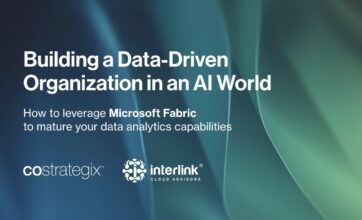Where Do I Start with Data Governance?
- 5 minutes read
If the volume of your data is exploding and you lack a good data governance framework, you’re not alone. Every business and IT professional knows the wisdom in gathering data – it provides the opportunity to discover new insights, improve business processes, and revolutionize industries. But what happens when companies become overwhelmed by all their new data? What happens when the flood of information becomes noise, and finding insights becomes like finding a needle in a haystack?

The global datasphere – or the amount of data created, captured, and replicated in any given year across the world – is estimated to grow to 175 zettabytes (ZB) by 2025, according to an IDC Report. In case you aren’t familiar with a number that high – that’s 1021 bytes of data, or 10 with 21 zeroes after it! That’s higher than we can count.
How will companies gain control of their data and turn it into a true strategic asset? This is where data governance comes in.
What is Data Governance?
So how do you define data governance, and how do you execute it? First, let’s look at what data governance is NOT. Data governance is not a technology tool, though there are technologies that can help. It is not a rigid set of rules or precise steps every organization must follow in lock-step order. And it is not the responsibility of just one area of your business.
Data governance is a combination of processes, people, and technologies used to manage an organization’s data assets. Data governance is a framework that you adapt and mold to your business and the specifics of your data environment. Just as no two companies are alike, neither are two implementations of a data governance program.
The Data Governance Institute defines data governance as “A system of decision rights and accountabilities for information-related processes, executed according to agreed-upon models which describe who can take what actions with what information, and when, under what circumstances, using what methods.”
Elements of a Data Governance Framework
While data governance is not a new concept, its importance in today’s business environment is increasing with every byte of data created, and with every data warehouse and data lake established. Enabling data-driven decisions can only be done if accurate data is available at the right time, to the right people. Here are some of the key elements that go into establishing your data governance program:
- Improving Data Quality: By improving your data quality, you help ensure that your business leaders trust the data. The best way to do this is to monitor quality continuously and ensure the appropriate people are aware of and empowered to fix any problems that are found.
- Making Data Searchable: You might not be looking to provide open access to data for everyone in your system (full data democratization), but breaking down data silos, capturing lineage and traceability throughout a data ecosystem, and making data searchable are key to unlocking discovery and eventual insights.
- Facilitating Compliance Requirements: PCI, HIPPA, and GDPR are only a few of the compliance requirements organizations must adhere to these days. The list of consumer protection laws and financial institution regulations continues to grow, and ensuring that you can not only maintain compliance but prove compliance is top of mind for many business leaders and executives alike.
- Speaking the same data language: Marketing, finance, and IT all create reports, but often with different definitions for the same terms. For instance, your team might have different terminology or definitions for something as simple as who a customer is. This causes confusion and lowers confidence in the data and insights you’re able to provide. Standardizing enterprise views and definitions allows everyone to have a common understanding of your data and its meaning.
A Fluid Approach to Data Governance
It might feel daunting to think of the scope of a data governance platform – and the organizational change required to make it successful. As with any initiative of this size and importance, we find it is best to “eat the elephant” one bite at a time.
Think about it this way: Creating your data governance strategy is like defining your why, your “North Star,” what you aim to achieve. Implementing that strategy means taking a step-by-step approach, and deciding which steps must be done first. You’ll want to define an element of data governance to start with, and then begin to build momentum. Your first initiative should be to alleviate your biggest pain point – for instance, improving data quality, or meeting GDPR requirements.
If we take GDPR compliance as an example, you may determine that you first need to know where all of your customer data is located. Then you’ll want to begin by cataloging your data sources and curated data sets and tracking the traceability and lineage of that data. In parallel, you would want to establish data stewards across your business and begin building a business glossary with enterprise definitions to apply to the data in your catalog. All the while, you would do periodic checks back to your strategy, and either course-correct or tweak your strategy as you uncover new information.
As a data and analytics consulting firm, CoStrategix specializes in data governance strategy and execution. We bring an “intentional” approach that is unique to your organization. We have seasoned data professionals with years of experience in implementing data platforms, standing up data governance programs, and enabling businesses to unlock the power of their data. We understand the challenges that you face in today’s digital world, and the opportunities that governed data can provide.
Let us help you with: • Governance processes, roles, and responsibilities • Data stewardship • Defining business processes and a glossary of terms • Master data management • Data quality and metrics • Metadata enrichment • Data catalogs
We are strategists, thought leaders, and action takers, and we’re here to help you make your data work for you to become a truly strategic asset to your organization.
AI Strategy & Solutions – Elevate your business with advanced analytics
Data & Insights – Drive insights that lead to competitive advantage
Product Development – Build platforms that power unique digital capabilities
Platform & Technology Modernization – Modernize for stellar experiences, efficiency, and AI
Related Blog Posts
4 Pitfalls to Avoid When Creating a Customer Journey Map
October 26, 2020
Composite AI: The Smarter Way to Navigate AI Complexity
March 4, 2025
Building a Data-Driven Organization for an AI World 2
February 5, 2025
Building a Data-Driven Organization for an AI World
February 4, 2025







